
As far as amusement arcades go, Funspot, in Laconia, NH, is big.
According to their website, they are ‘the largest arcade in the world‘. But how does that claim measure up against reality? And what, in any case, is the quality of the experience on offer?
Definitions are important here. For collectors and connoisseurs of classic video arcade games, the term ‘arcade’ has become synonymous with the larger of the rooms or buildings in which those kinds of machines were once housed – the smoky palaces of bleepy, bloopy thrills and escapism that dominated the seaside towns, and occasionally city-centres of yesteryear.
But this is where we need to stop for a minute and think. With the arcades of the Golden Age surviving only in our heads, we tend to fixate on the part of the arcade experience that appealed to us the most – the video games. Fuelled by YouTube tours of private collections, and photo galleries of arcade ‘holy grails’ on forums and blogs, there’s a tendency to dwell on the alternative reality of what Jonathan Meades calls the ‘Mythical Arcade’. I’ve been guilty of that myself. And why not? It’s a wonderful mind-spot to visit! Wouldn’t it be great if there had been dedicated, barn-like venues with an exclusive focus on the appreciation, and competitive enjoyment of video games ? It’s little wonder that our collective memory has coalesced around the false recall of that idea.
For those of us who spent out formative years in UK arcades, however, the truth is that these places never really existed, certainly not on a large scale. I’m not talking here about the high-street backrooms, or computer shops, or chippies that might have housed a few ‘spacies’. If you relax and let your genuine gaming-memories bubble up to the surface, you’ll remember that what we actually had in the bigger arcades was a mixed economy of penny-pushers, one-armed bandits, horse racing, bingo and other low-stakes gambling opportunities as well as video arcade games – but with the later only usually in the minority. Formally, the largest arcades were recognised as ‘family entertainment centres’, designed to attract the broadest possible demographic, and part them from the biggest possible chunk of disposable cash.
In that sense, Funspot isn’t really an ‘arcade’ at all. But neither can it be described as a mere family entertainment centre. No, it’s a venue which prides itself on the elevated status of ‘Family Entertainment Super Center’ – with quite some justification. You see, Funspot isn’t just a room, or a building. It’s not even a building with several floors. It is what can only be described as a compound – a sprawling complex of multi-storey-buildings strewn over a site covering several acres.

Perhaps I should qualify that observation. The word ‘compound’ has acquired some unfortunate connotations over the years. And for the casual reader, this image of the LED billboard on Endicott St. won’t help to allay those fears. Don’t worry, though – this particular compound is not home to a disturbing survivalist cult. Or at any rate, not a violent one! What you can read on the billboard is actually the state motto of New Hampshire, which harkens back to Revolutionary times, in which context it makes a lot more sense!


Most of the buildings at Funspot are inter-connected, with a few others set apart. All are enveloped within an enormous parking lot with space for several hundred cars and – potentially – thousands of visitors.
In the summer months, the activities spill out beyond the parking areas onto a crazy golf course, ice-cream pavilion, picnic area and more. This place is huge!


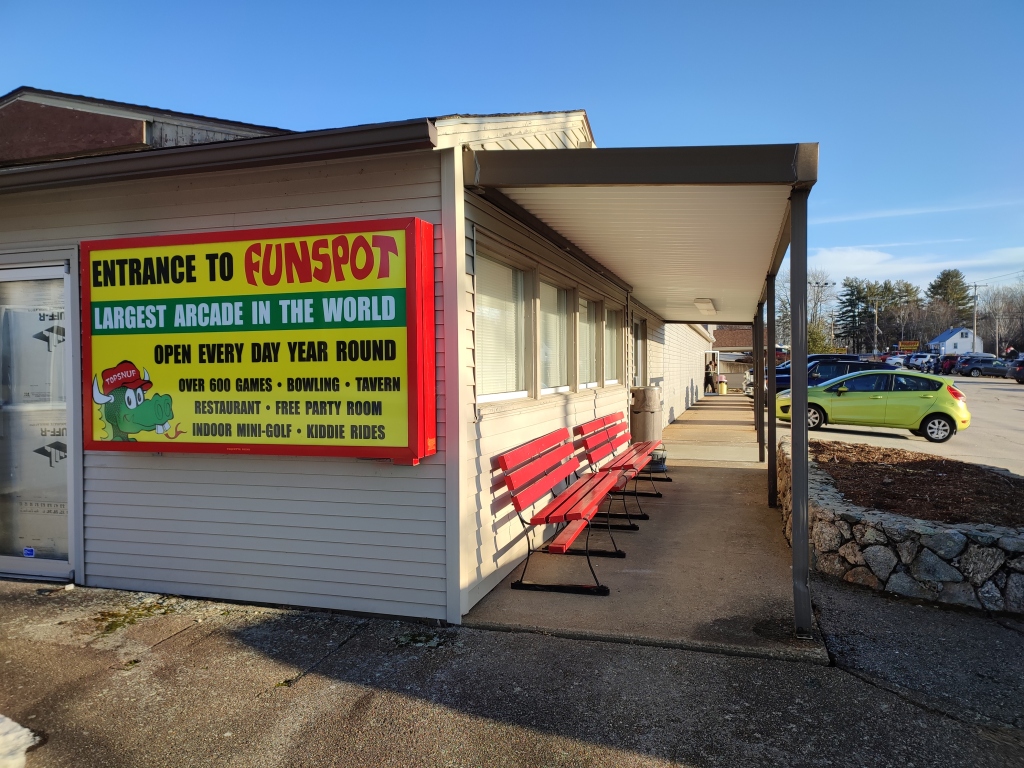


Inside, there’s plenty to keep the whole family busy. There are 20 bowling lanes – half 10-pin, and half candlepin. There’s a crazy golf course, there’s a cafe – the Braggin Dragon, and a bar – the D.A. Long Tavern. There are dodgems for the kids, and several floors of redemption machines, spewing out tickets that can be swapped for sweeties, toys and keepsakes.
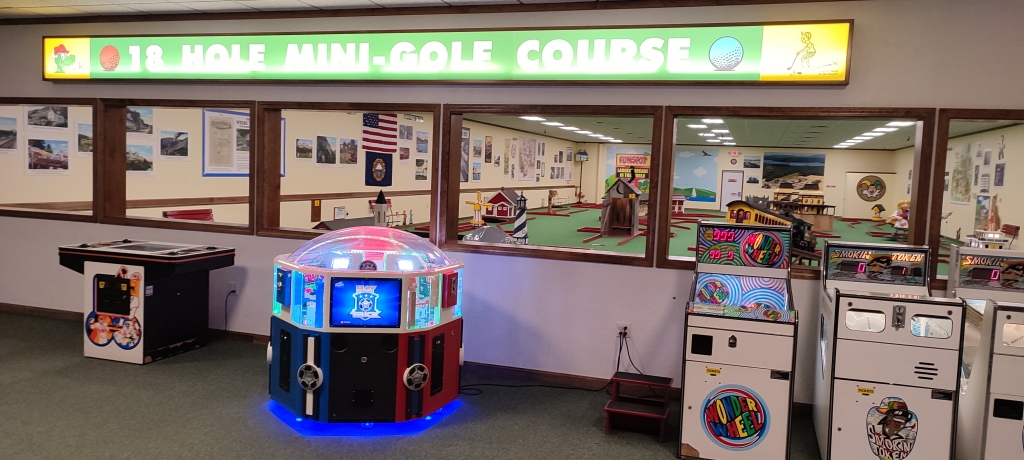
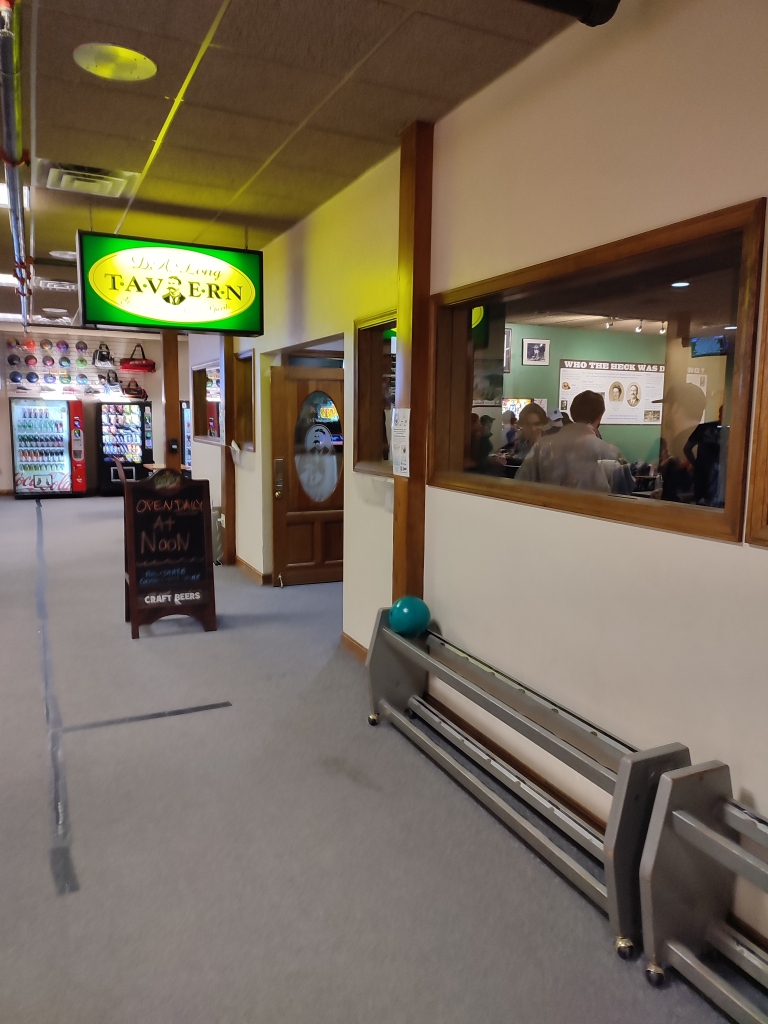

There’s even a separate bingo hall. And that’s all well and good. I enjoy the odd punt on the redemption machines myself. Once you’ve figured out the most ‘rewarding’, and more importantly, how to maximise you chances of winning – you have the challenge of trying to get yourself a commemorative mug or t-shirt for less than it would cost to buy one outright in the shop!

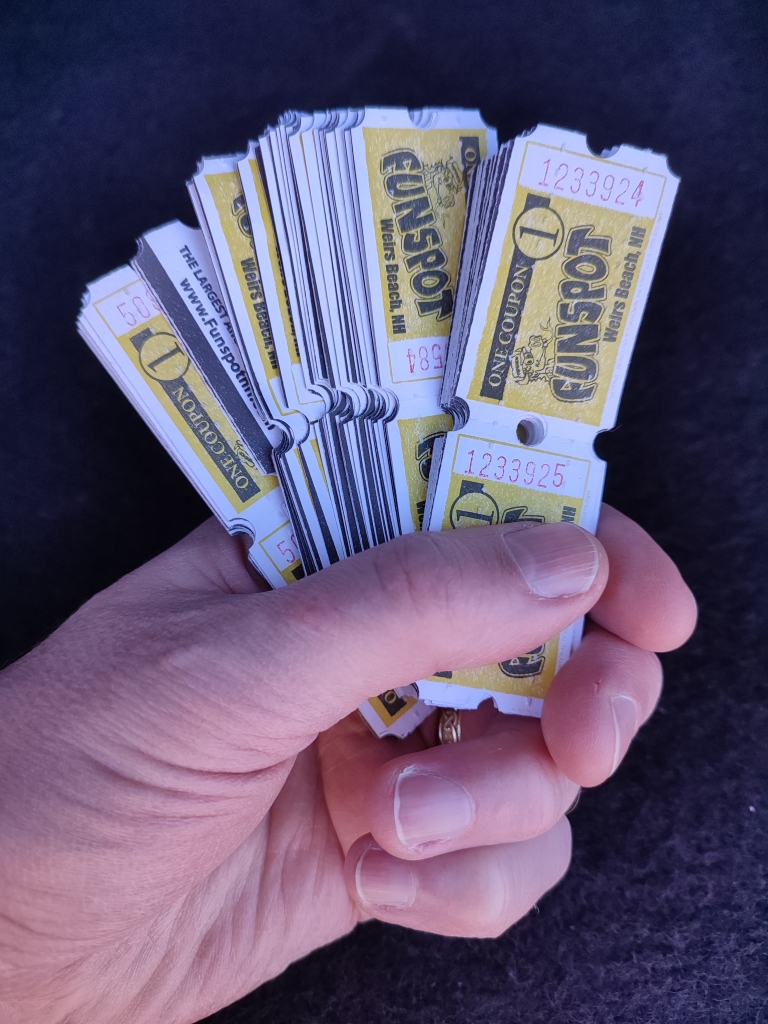

But none of that is what we’re interested in! Coming back to our implicit understanding of the term ‘arcade’, the thing we really care about is its collection of ancient and historic video games! And this is where we have to make another distinction. If Funspot is the Family Entertainment Super Center, only a small part of it it would be considered an ‘arcade’ – and that is the American Classic Arcade Museum – or ACAM for short.
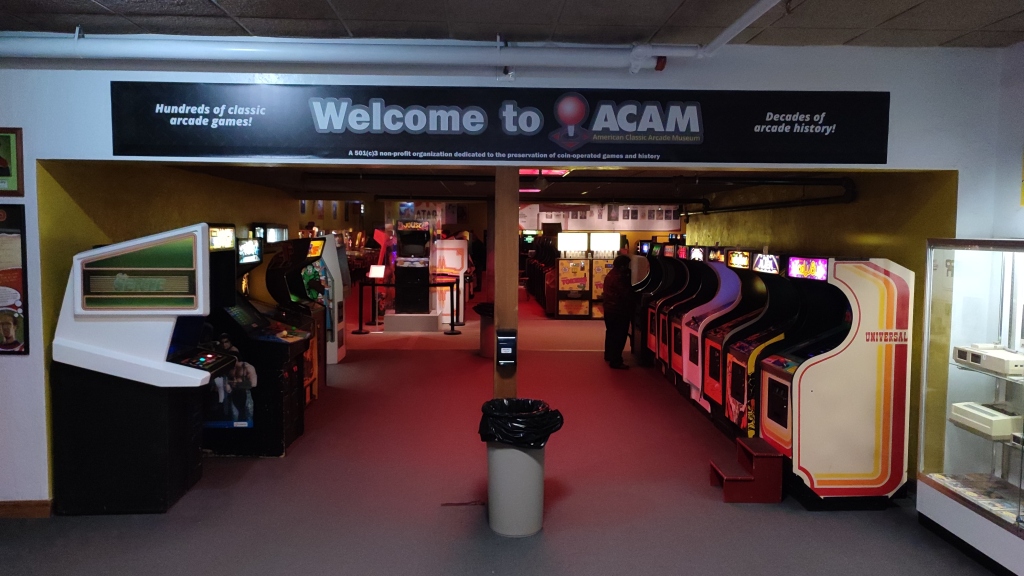
ACAM occupies only one part of one floor in one of the buildings at Funspot. But that doesn’t mean it isn’t large, or worthy of a visit…
Nosir, ACAM is not just #ossum, its #OssumSosBoss!
It is precisely how we would imagine a Meade-ian mythical arcade. The electronic glow from its rows and rows of carefully-curated video-games, draws you in to its half-lit sanctuary of retro-gaming history. Soft-rock classics from the 70s and 80s waft from the PA system to help ease you into your journey. I suspect that if you stood still for just a bit too long, you’d end up stuck there, not just mesmerised by the fosfor-induced nostalgia, but frozen solid for all time in pixelated carbonite!
While ACAM is packed full of video arcade machines, it doesn’t feel crowded. The aisles are wide enough to allow players on both sides to adopt even the most preposterous of arcade ‘stances’, and still allow free passage in between. More importantly, things have been arranged so that side art is always at least partially on display when warranted.
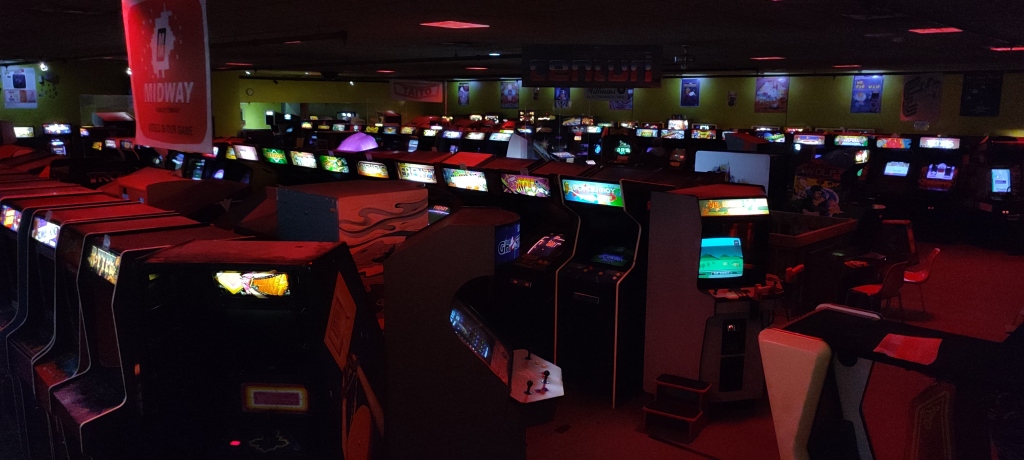
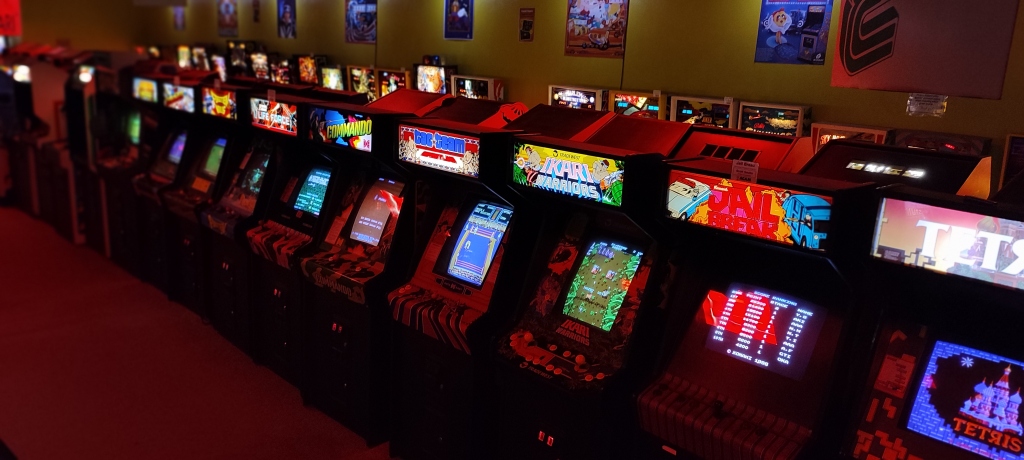
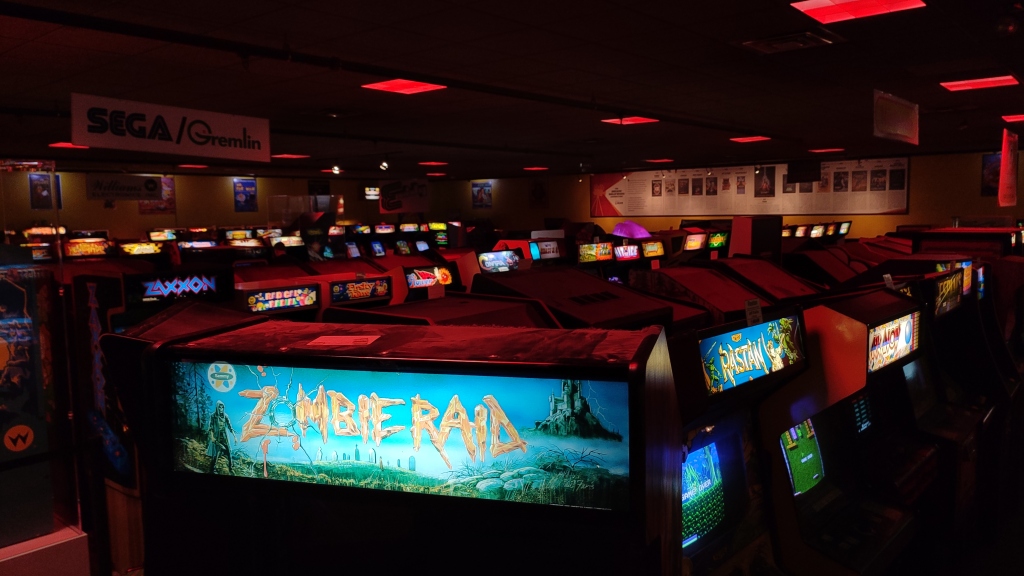
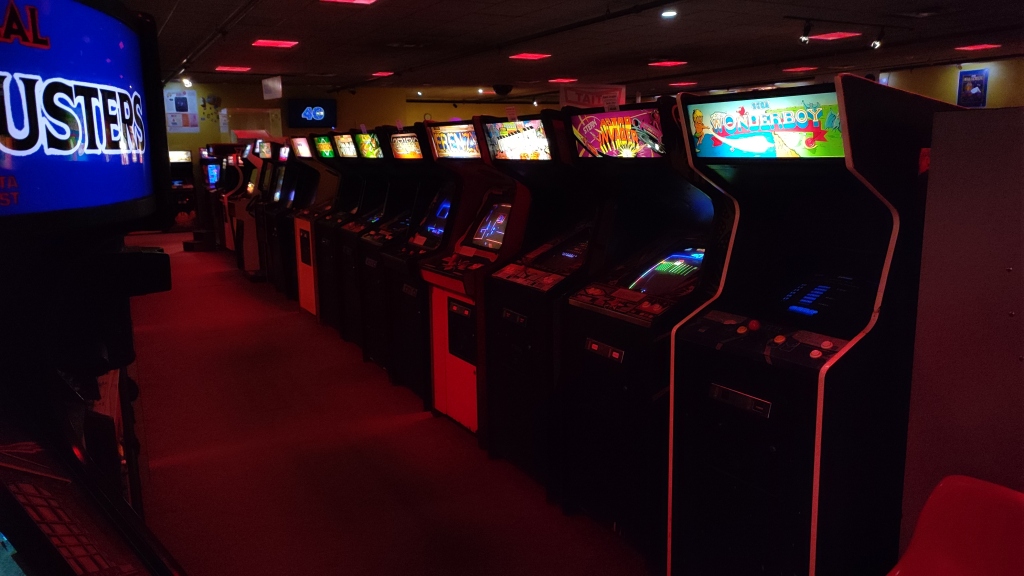


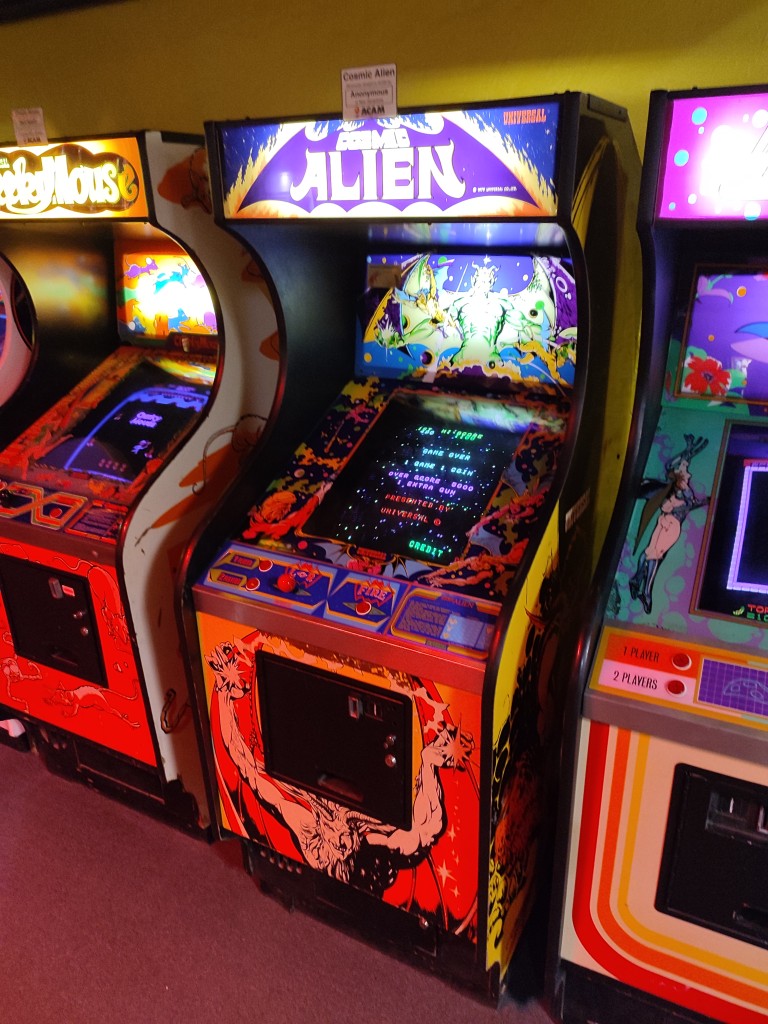
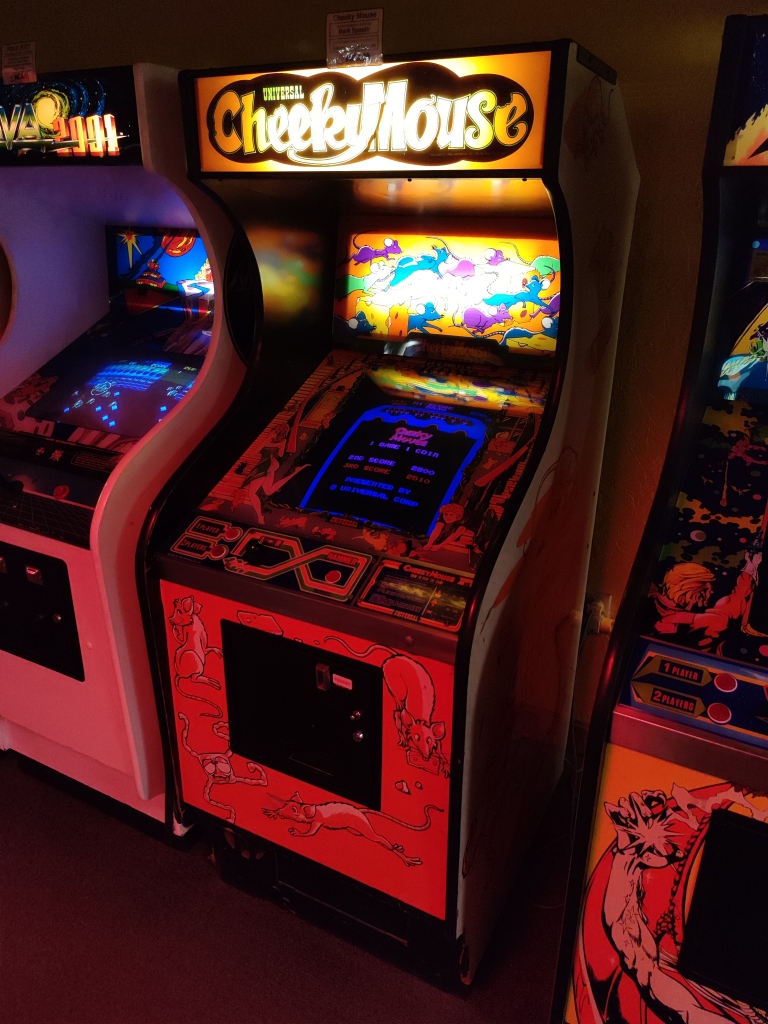

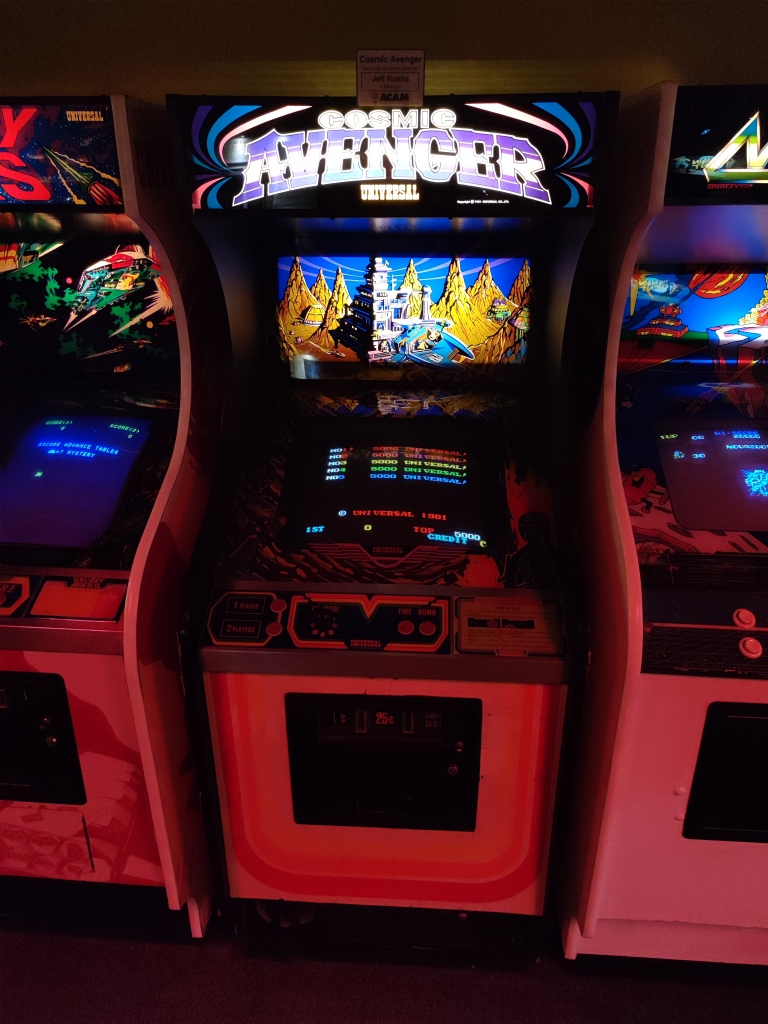
To get the full effect, I recommend making your first entrance through the bannered entry on the top-floor, opposite the indoor golfing centre. But once you’ve done that, and had an explore of the main buildings, you should try again using the steps that come up from the floor below. Perhaps on the way back from a sneaky refreshment in the D.A. Long Tavern, or from having a go on the touching, and not-at-all-gimmicky homage to Irish cultural heritage, Leprechaun.
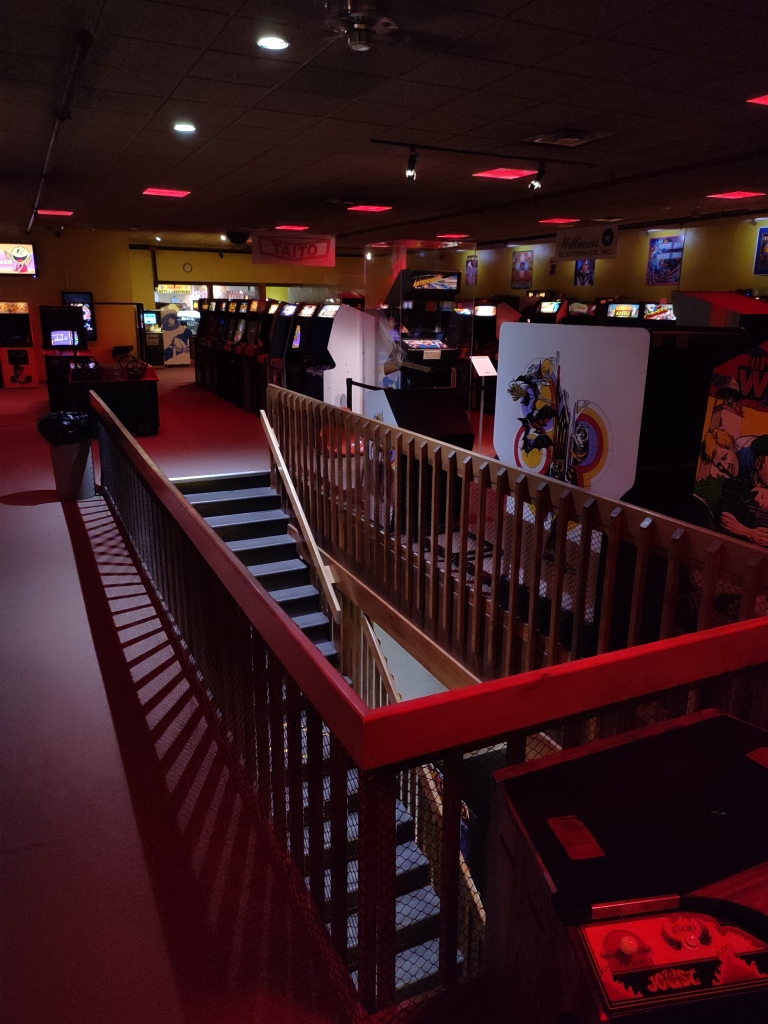
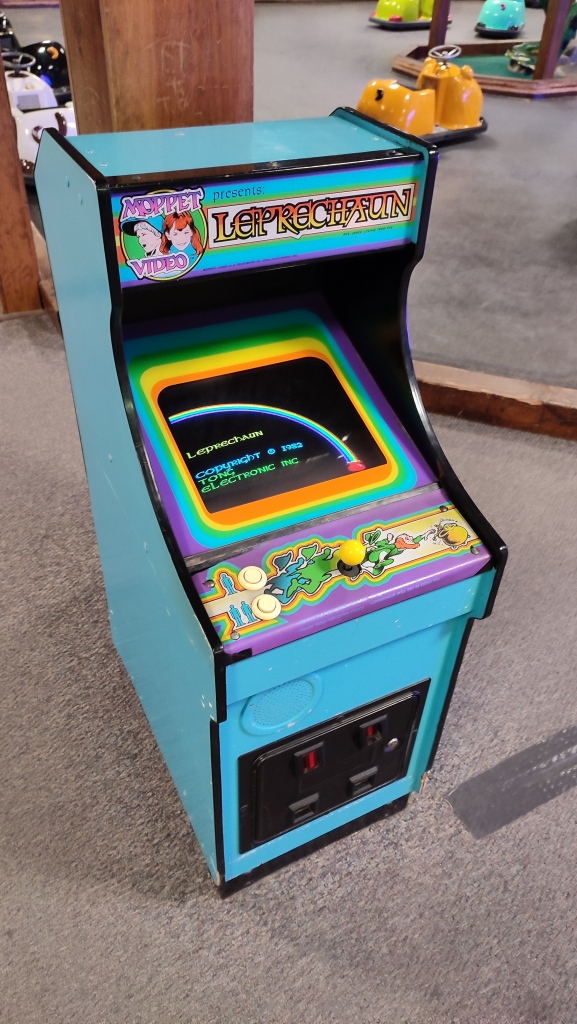
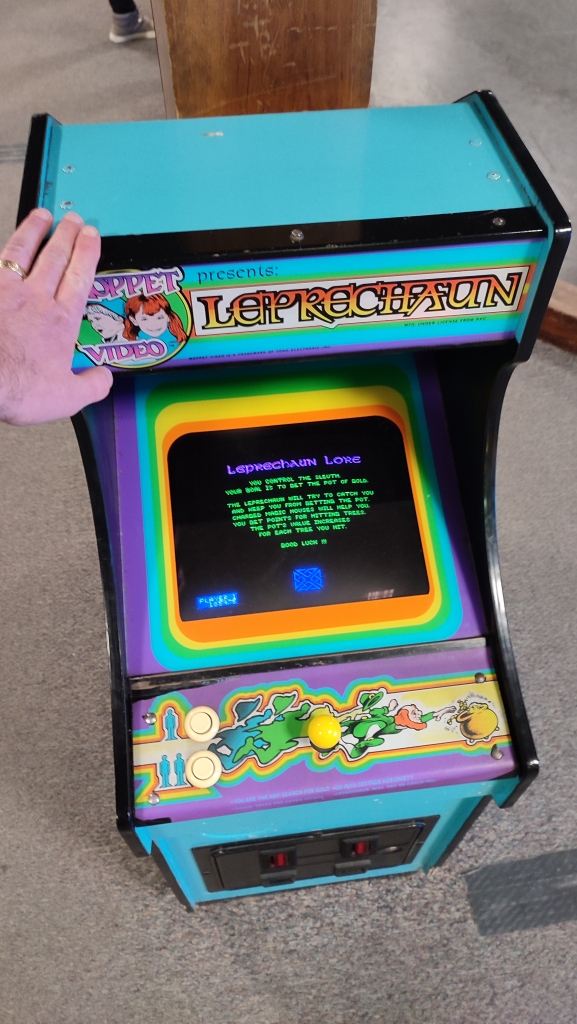
It’s worth pointing out that while base-line snackage, such as ‘soda’ and ‘candy bars’, is available from vending machines, your options for more substantial vittles will be limited to the pizzas and other items on sale in the Tavern through the week, outside of peak season. At the weekend, however, you can also avail yourself of the culinary delights of the Braggin’ Dragon, whether that be Chilli-Cheese Dogs, Onion Rings, Fries, or all three!

NB: while the hotdog in the picture looks small, that’s an optical illusion caused by the relative size of the ketchup pots. These aren’t the inch-wide thimbles we get at McDonalds in the UK, what you’ve got there is a pair of two-and-a-half-inchers!
While there are some games from most years between Atari’s 1972 Pong and the late 1980s, there is a noticeable, and pressumably intentional emphasis on older models, many of which are not just unusual but downright rare. I saw plenty of games, which I only vaguely remembered from back in the day. Some of these, like Midway’s 1976 submarine classic, Sea Wolf, brought back particularly fond memories (read the first blog in this thread!). Shame it was out of action. Luckily, from what I remember, it was vaguely similar to Destroyer and Depth Charge, which they did have – in full working order – so I had a few goes on those instead.

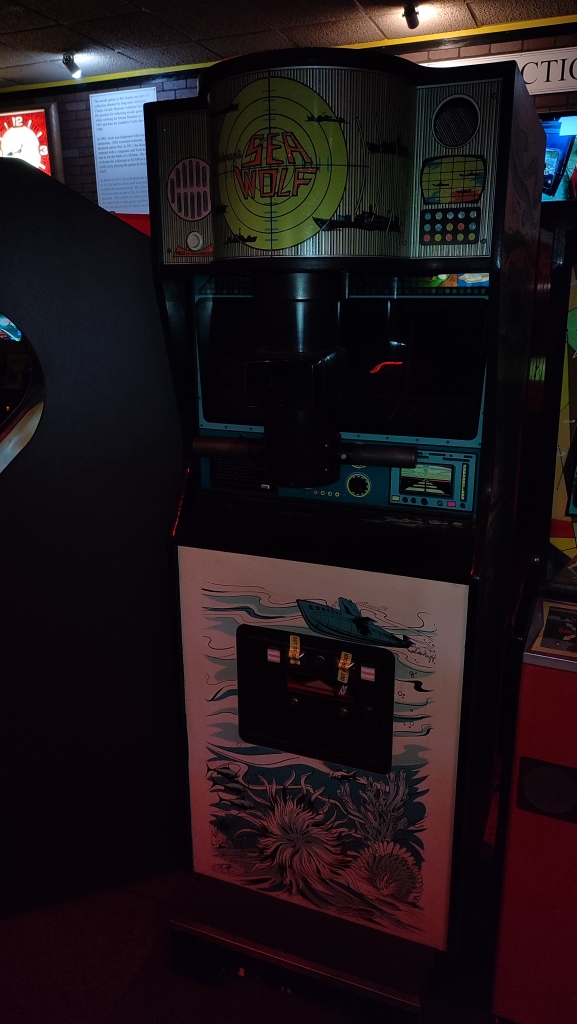
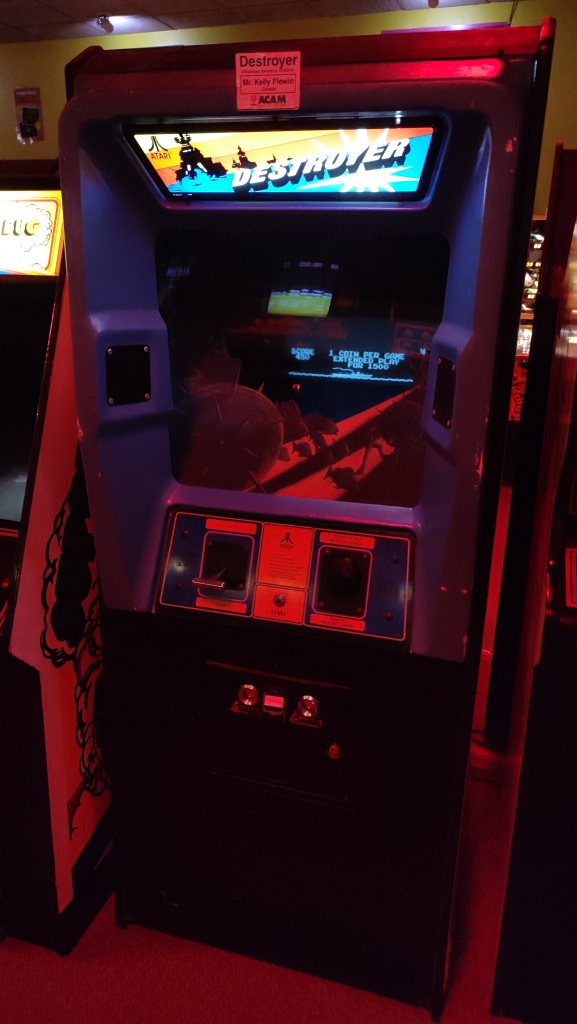

I was also pleased to see a pristine example of the notorious Death Race, a two-player, top-down ‘racer’, with a single screen, where you compete to see who can run over the most ‘zombies’ in their sports car! It’s not a high-scoring game – if you can break into two figures, you’re doing well. Not something to emulate out on the roads either!



If you’ve enjoyed the arcade doc- (or should that be mock-)umentary, King of Kong, you can take your chances on the same Donkey Kong machine that’s inspired champions for decades. In fact, it sits in the middle of an impressive row of Nintendo cabinets, with all the Kongs, Popeye, R-Type, and more besides (NB: The R-Type pcb is by IREM, but was served up for the US audience in a Nintendo cabinet).
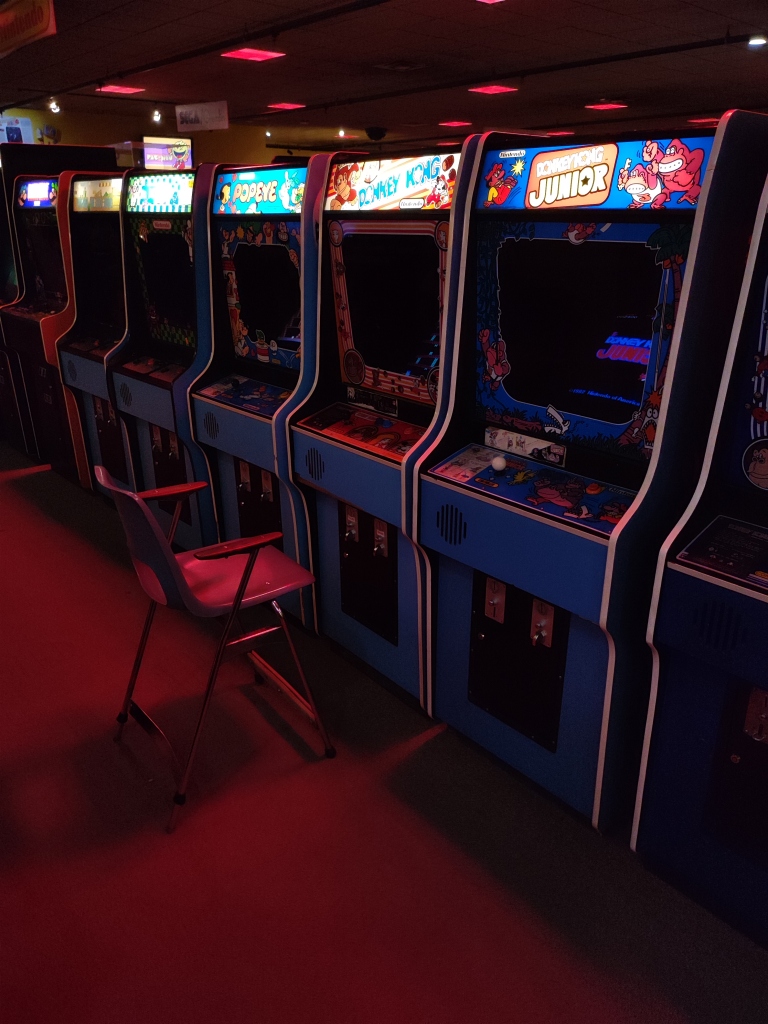
Other highlights included cockpit versions of Sega’s marvellous racers, Turbo and Monaco GP. Both use the same basic game mechanics, which – despite entering its fifth decade – remains surprisingly good fun. It’s smooth, responsive, fast – and, bascially, easy to pick up, but difficult to master.
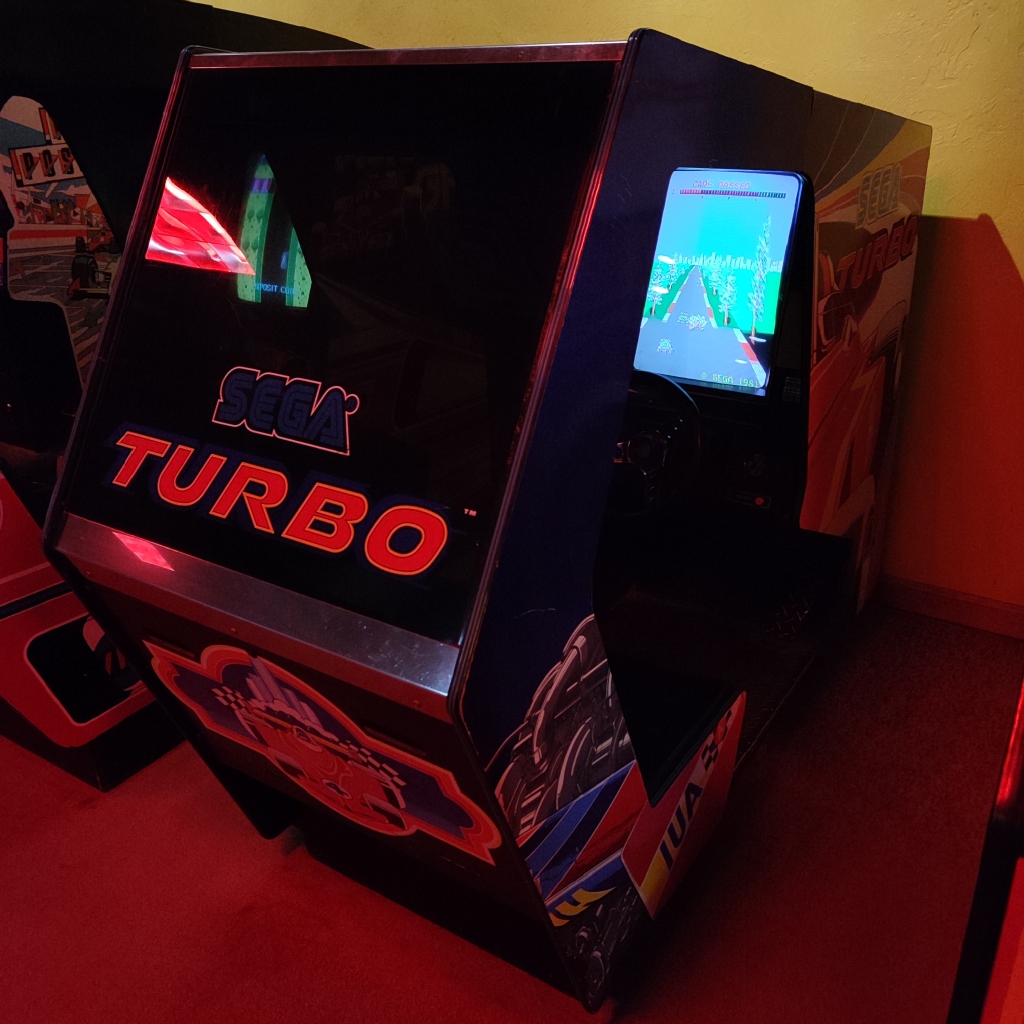
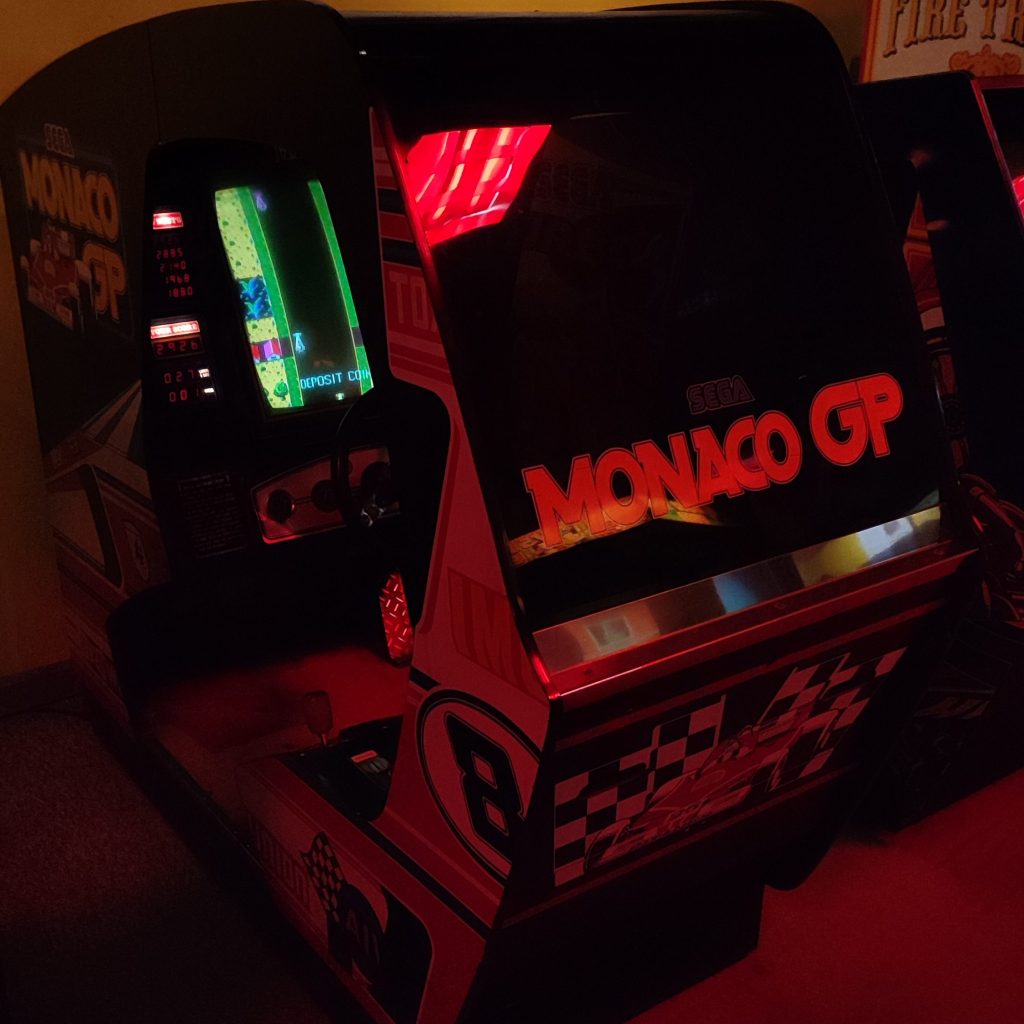
Something else you’ll find out on the floor, which I’d heard about but never seen before was the vector-based space simulator, Star Tek. There is no doubting that the cabinet itself is a retro-futuristic work of art. And it certainly had the potential to offer an immersive experience in Captain Kirk’s chair. Sadly, IMHO, this is an opportunity missed. The game itself is shallow and repetitive, but not – it has to be stressed – in an entertaining way. I imagine that explains why I never saw one b.i.t.d.
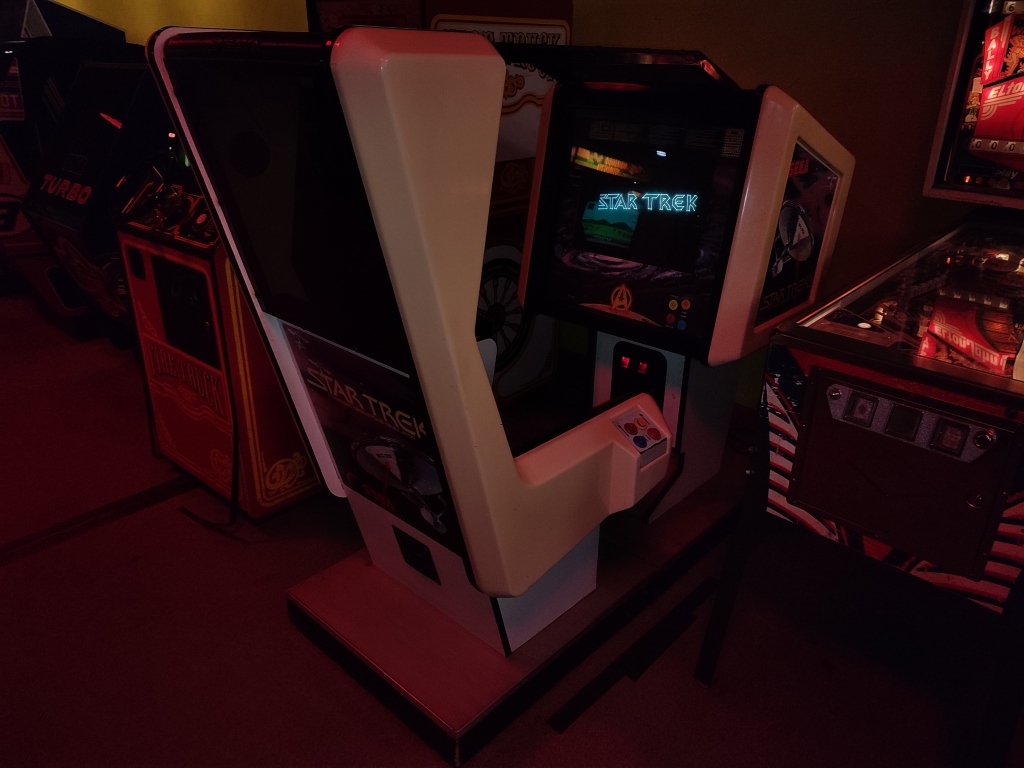
I also found myself drawn to Exerion, a midly nauseating, but strangely compelling inertia-based shooter, that I don’t think I’ve seen in the wild since the summer of 1983. It was one of two cabinets in the takeaway on a campsite I was visiting with my parents in France! I also dallied on the crisp Krull cabinet with its twin-sticked trickery; marvelled at the photo-realistic topper (kindof) on the Alien Syndrome machine, and spent a pleasant half-hour re-acquainting myself with the spinner-induced joys of Arkanoid. And how could I not sink some serious time into the original Williams Sinistar cab, with its still-responsive 49-way joystick. The difference this makes to playing in MAME on an 8-way stick is really quite something.
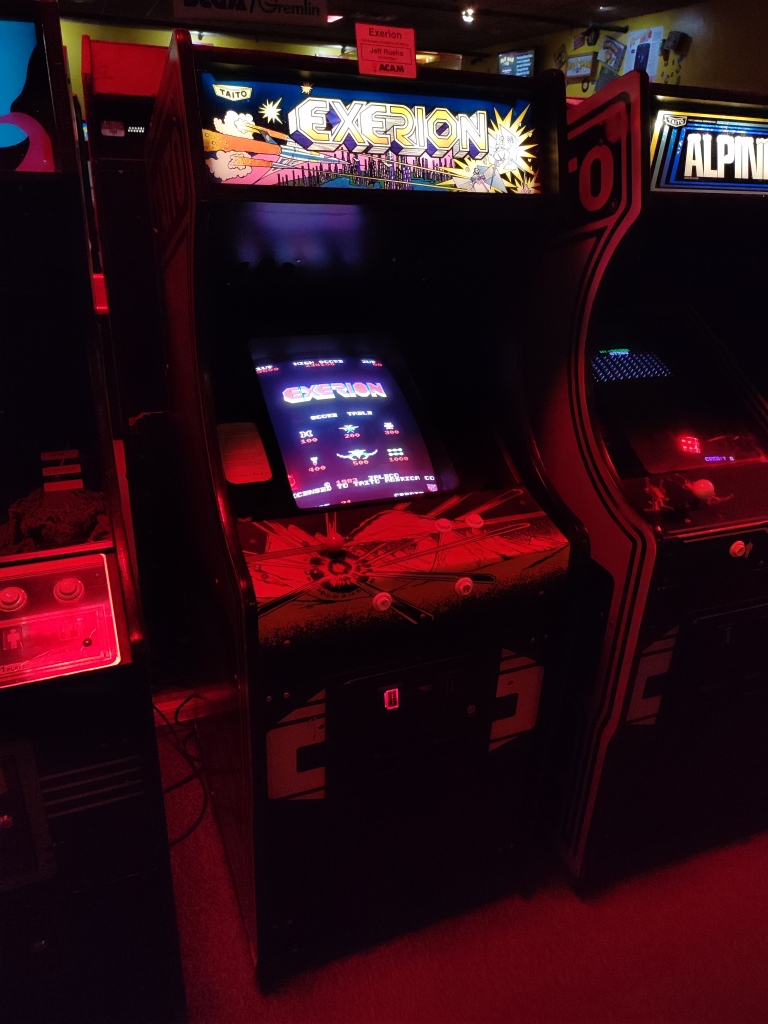


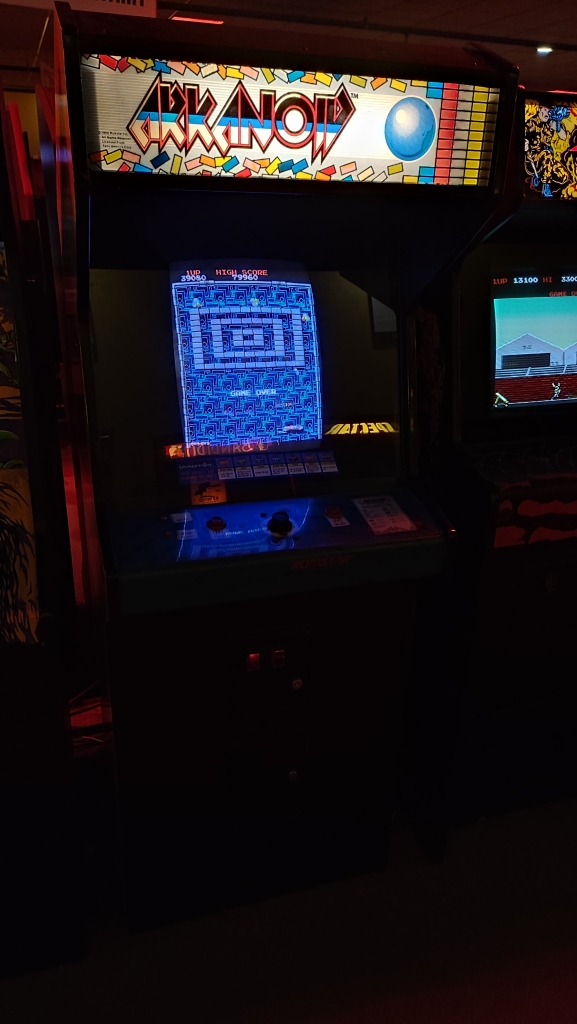
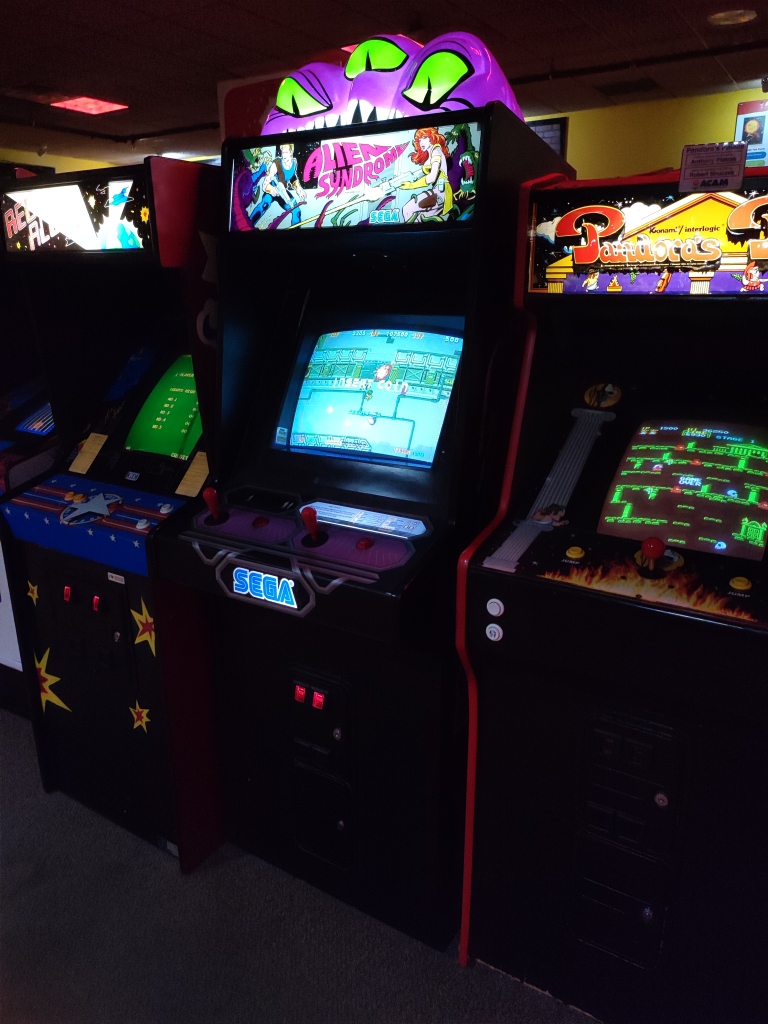
While there was a general lack of shoot-em-ups, and other games from the mid-to-late 80s, the range of other genres on offer more than made up for it. Amongst them was a bewildering array of strange old distractions, which could only reasonably be described as ‘janky’. Regular listeners to the Ten Pence Arcade Podcast would have recognised a fair few of these, such as Satan’s Hollow, Circus Charlie, Kamikaze, and Radical Radial. I’ll keep my fingers crossed that they steer clear of RR‘s evil cabinet-twin, Frisky Tom. It clearly crosses the line between janky and junk. Why they have it in ACAM, and not smouldering in ashes at the bottom of a bonfire, I do not know.
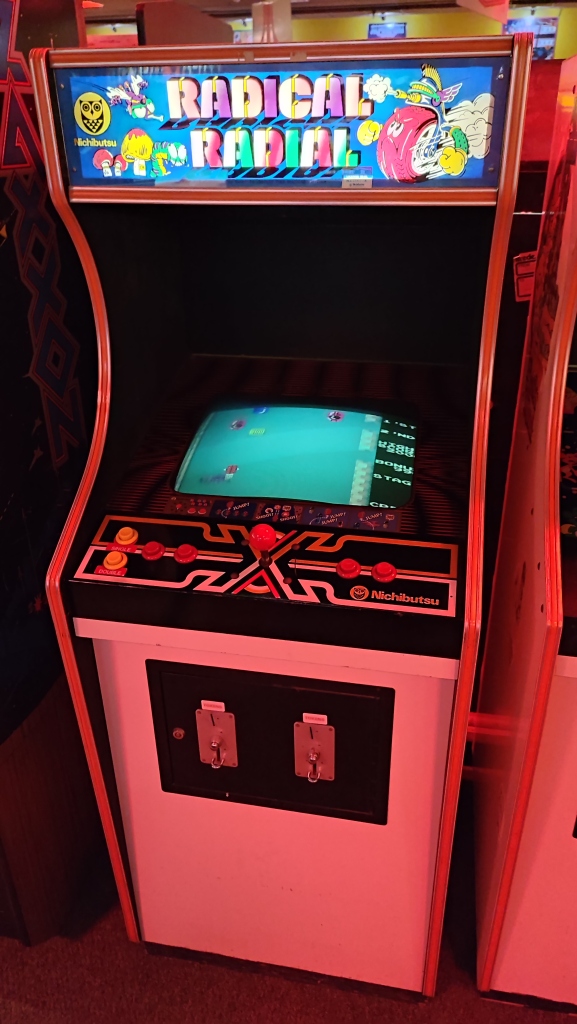
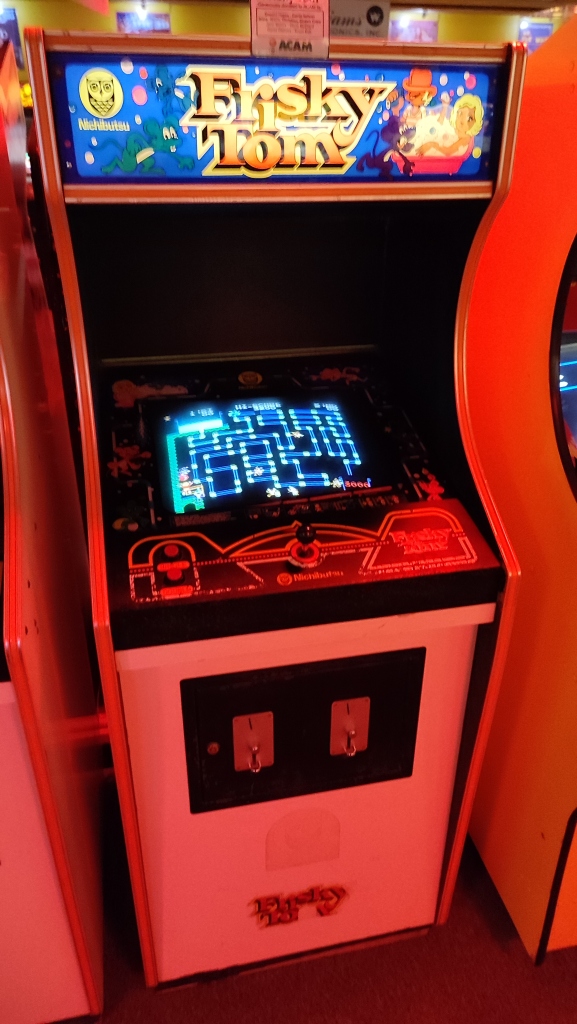
New discoveries for me included Timber – a really engaging twin-sticked-lumberjack game, starring the main character from the perenially-popular Tapper; and the janky shooter, Space Dungeon, which I reckon could be a grower. I also enjoyed reconnecting with Warlords – a fantastic multi-player game which holds up well for the single gamer; and Canyon Bomber, with its cross-over bomb/coin-drop vibe.



Beyond this, there was a representative selection of heavy hitters, including Robotron, Track’n’Field, Rastan, Pac Man, Missile Command, 720 Degrees, Rolling Thunder, Gauntlet, and Black Tiger to name but a few. Sadly, there was no Time Pilot ’84 out on the floor, which was a bit of a blow, as I was hoping to get some practice in it at the time for Arcade Archive’s February high-score challenge.

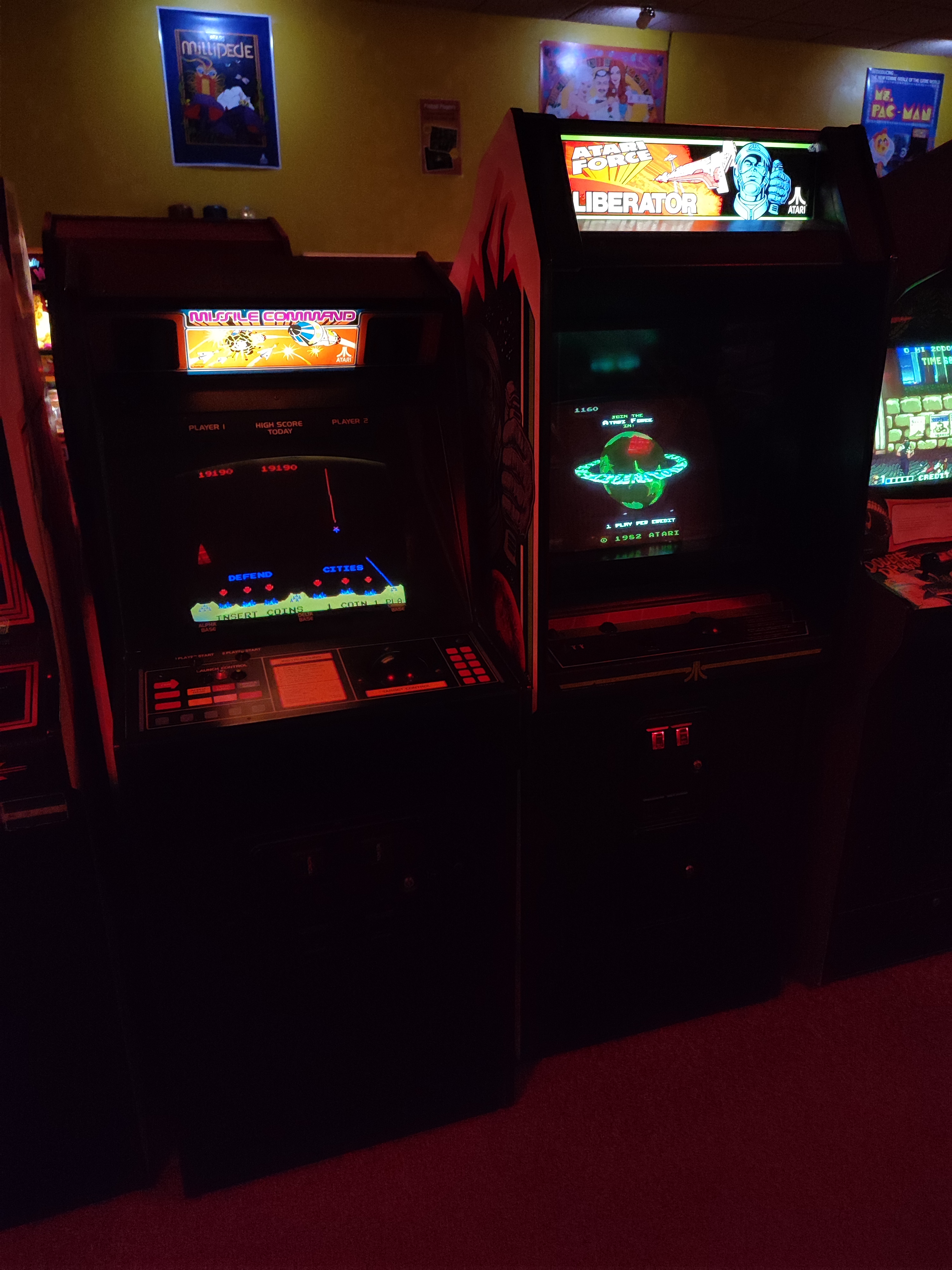
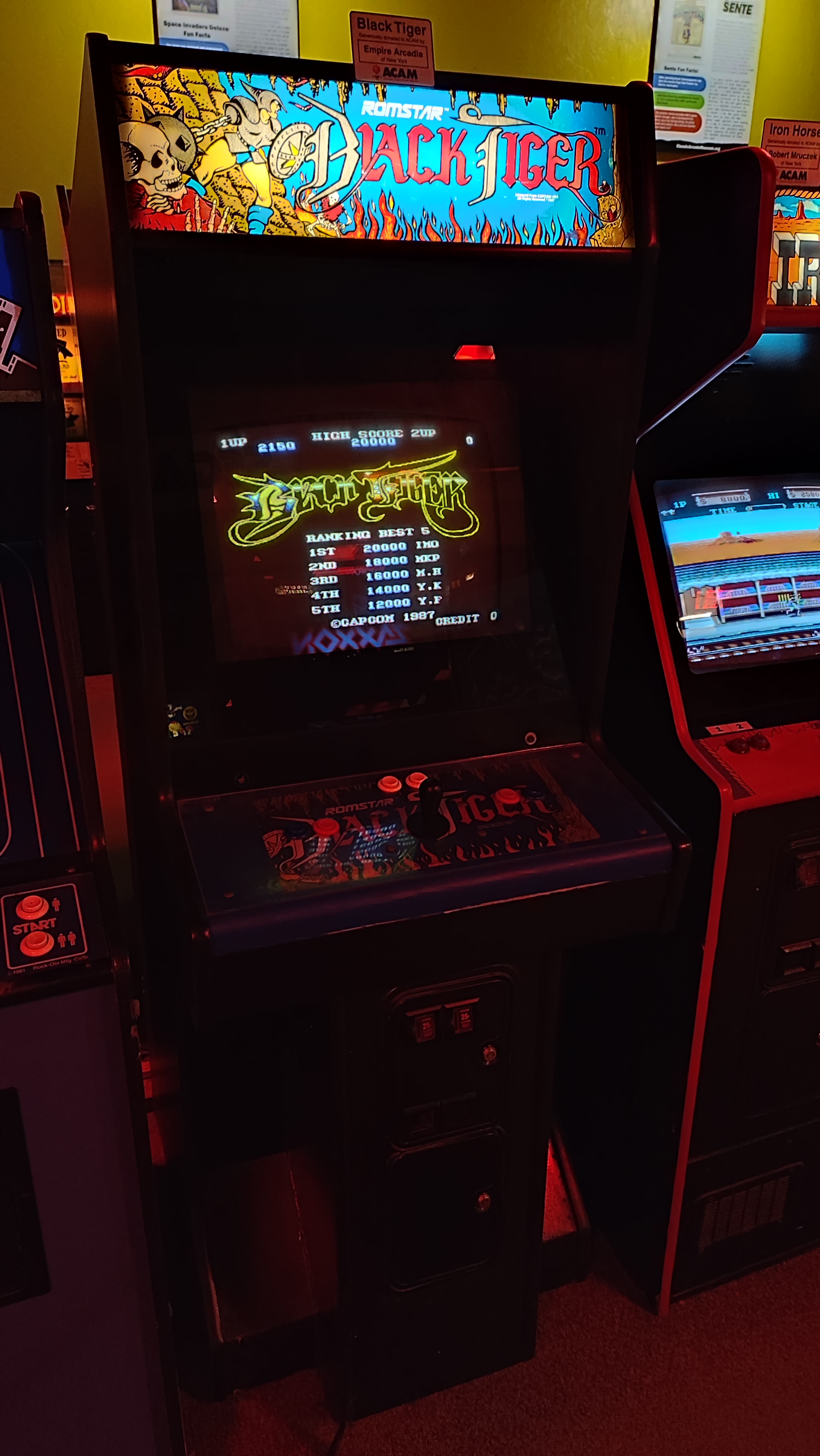

If that wasn’t enough, the electronic bleeps and bloops of the arcade games was complimented by the mechanical thwacks and thumps of a row of classic pinball tables. Stand-outs for me included Xenon, Gorgar and Black Knight 2000, but there was also a selection of older machines. Downstairs, en route to the D.A. Long Tavern, was a secondary collection of DMD-based pins.

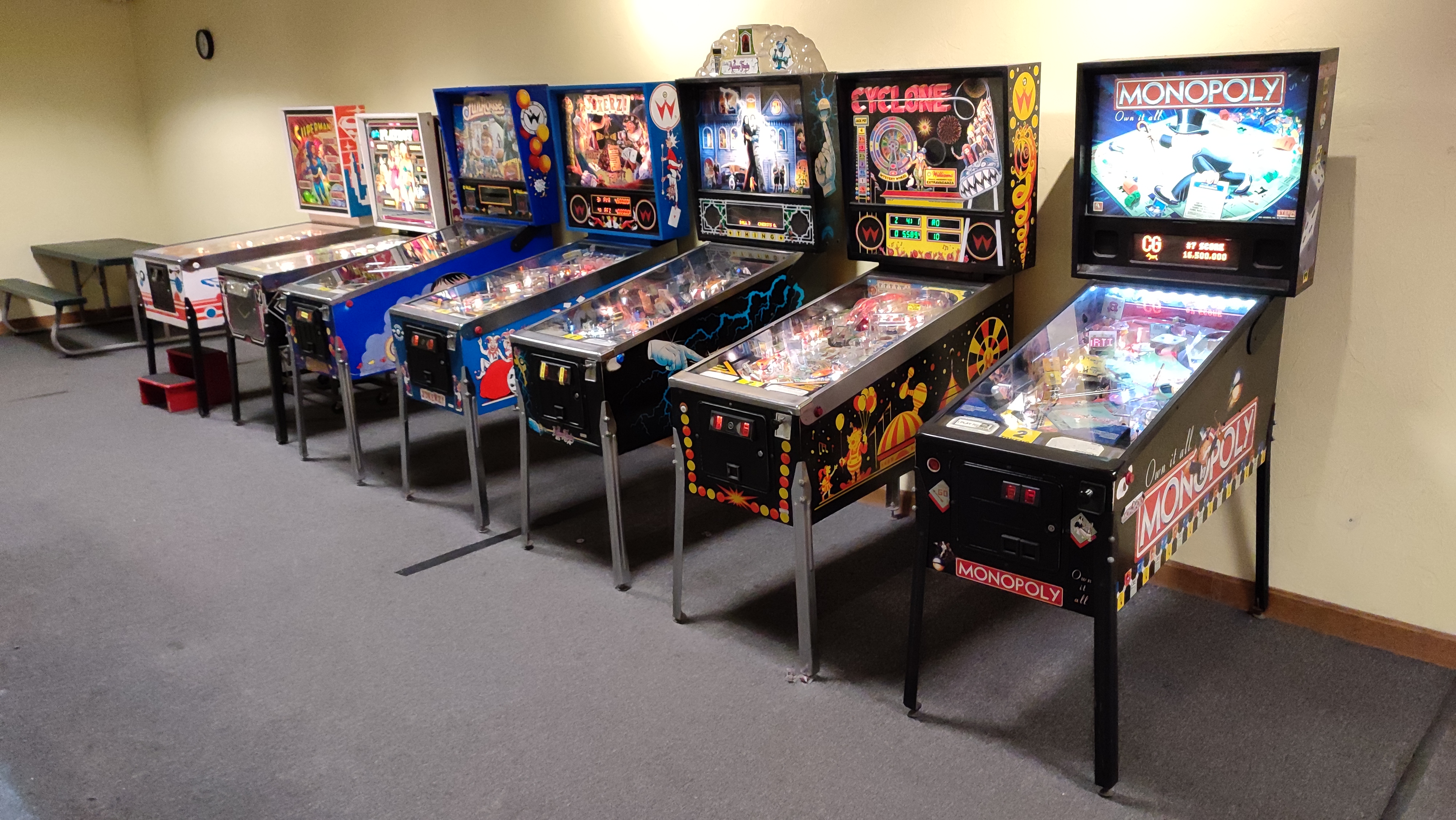

If there was one disappointment, it would have to be that there was no Rygar – unarguably (DON’T DARE!), one of the all-time masterworks of the video-arcade-game form, and I game where I am relentless pushing my personal best twoards the 5 Million point mark (yeah, #fr #srsly!)
With all of this sounding like a cut-and-paste description of a pretty exciting fantasy arcade, you might be wondering where the ‘Museum’ aspect of the title comes into play. Well, impressively, this descriptor is no mere confection or contrivance to lend the arcade a degree of gravitas. It is no symbolic blunt object, with which to bat away the painfully ignorant meddling of the Mary Whitehouses of this world. For reasons related to it’s funding model, ACAM is in fact configured as a bona fide museum, and is registered as such with the authorities. While you might feel that its collection of classic games would be enough in its own right to justify that status, ACAM goes above and beyond the call of duty in this respect.

At regular intervals throughout the arcade, you will find displays, installations, signage and interpretation boards that showcase pivotal moments, movers and material examples from the world of classic arcades. There are displays cases filled with early games consoles and cartridges, banners highlighting the impact of arcade culture on other aspects of popular entertainment, and boards telling the story of the machines that have been donated or lent by enthusiasts to be enjoyed by the wider public through ACAM. For those who’ve spent any time delving into the arcade scene on the internet over the past decade, there will be some familiar names here. There is also series of banners outlining the history of industry giants Bally-Sente, and their ‘multi-system’ cabinets, which form the backdrop to a row of the same cabinets, showcasing a selection of the weird and wonderful games that were sold for them. The example par excellence here is the bizarre ‘eat-em-up’ Snacks’n’Jackson – a game that needs to be seen rather than described!


Upping the ante in terms of scale are the apparently growing number of pivotal cabs encased in Perspex sarcophagi. But the largest artefact on display, by quite some way, is the Hercules pinball table. That thing is so big, players steer what looks like a baseball across its playfield.
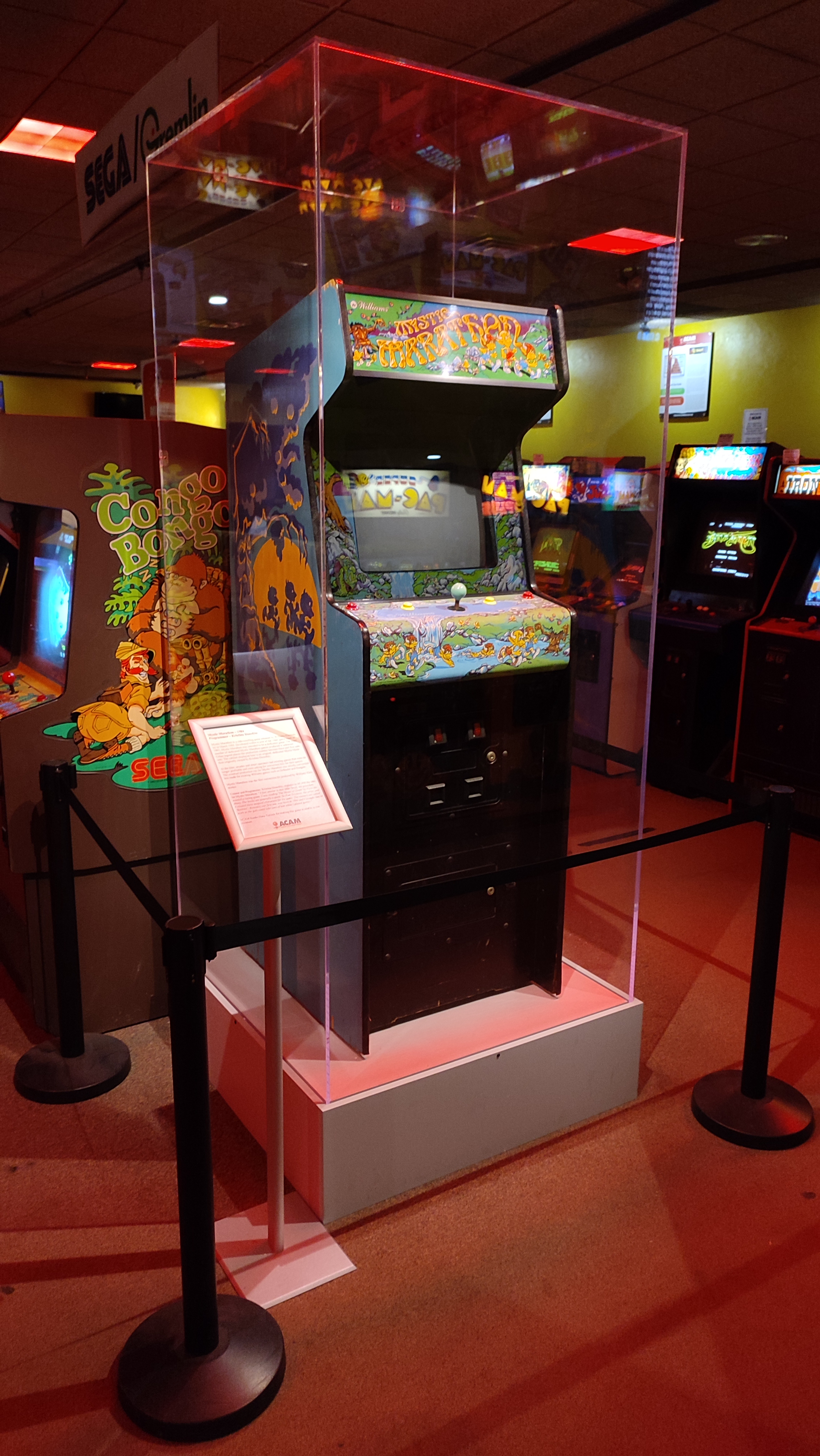
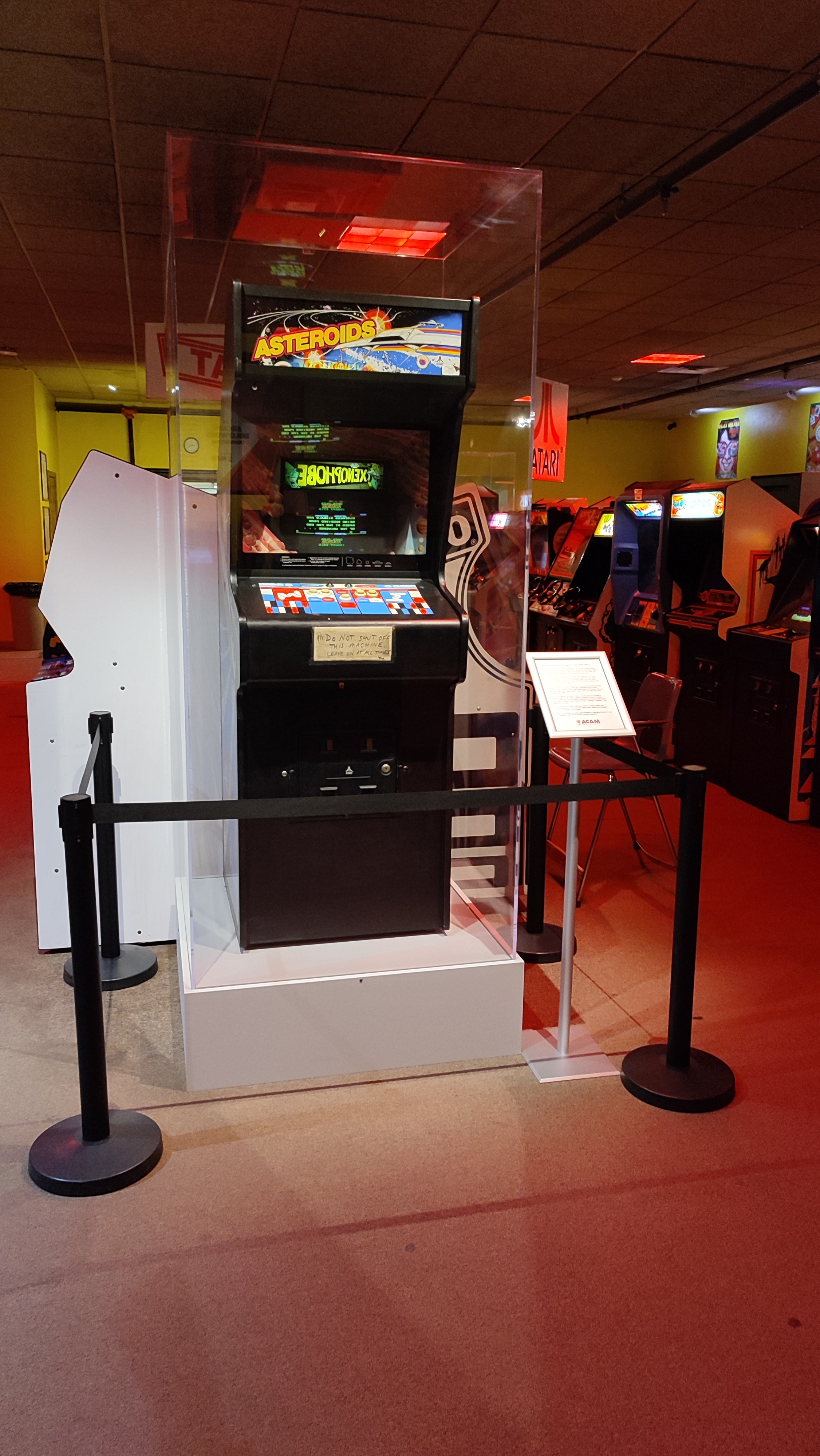
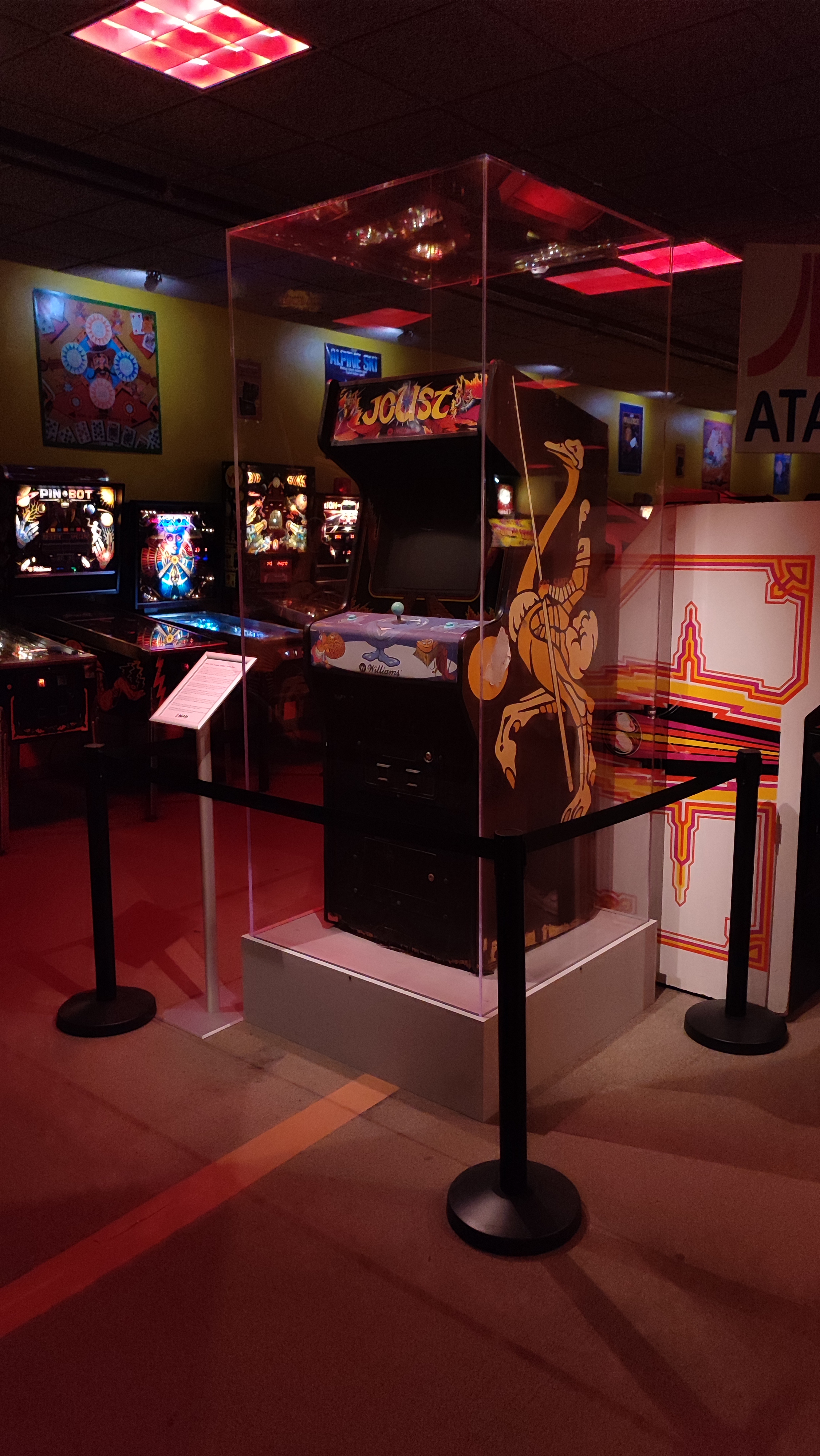

An unexpected, but welcome addition to the museum displays was what can only be described as a shrine to Keith Apicary – YouTube phenomenon and comedy creation of Nathan Barnatt. Not only do we get to see Keith’s certified score of -400 on Donkey Kong, as witnessed at ACAM, but also the actual Neo-Geo multi-slot machine featuring in the video for his (in)famous, Neo-Geo Song. If you’re having a look at that, do check out Nathan’s ‘Skittels’ (Skittles) Song while you’re at it. Top notch nerdery!
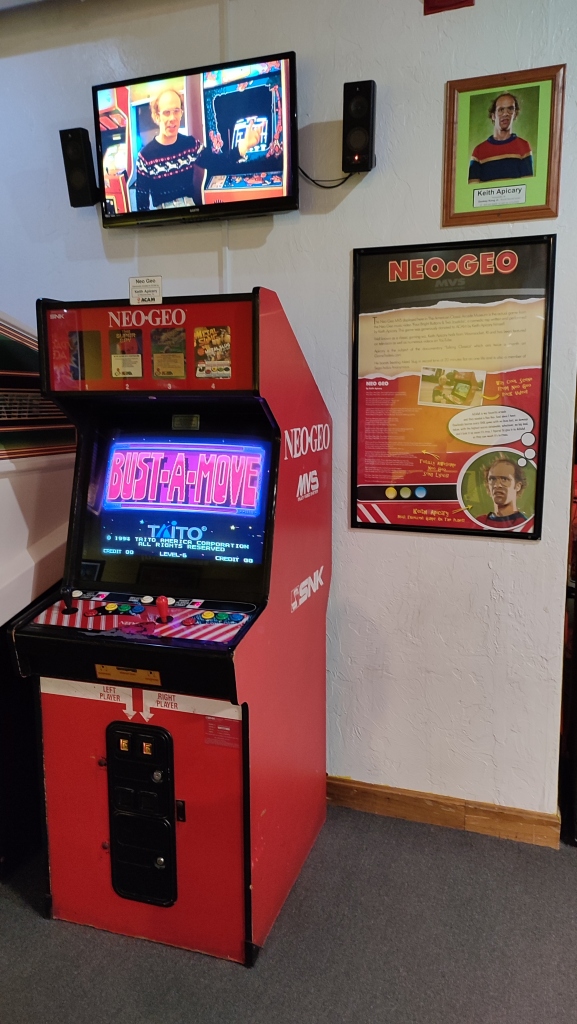

Now onto the more sombre stuff.
ACAM was great, as was Funspot. Full-stop.
Something that worried me a bit about both, however, was the way you pay for the experience. The machines throughout are operated by tokens, you see, which you can buy with cash or card from dispensers in the main entrance. On one level, this is quite nice. I like dropping coins (or tokens) in the slots. It really twangs my nostalgia strings. I even have my JAMMA cabs at home set up to run on old 10 pence pieces.
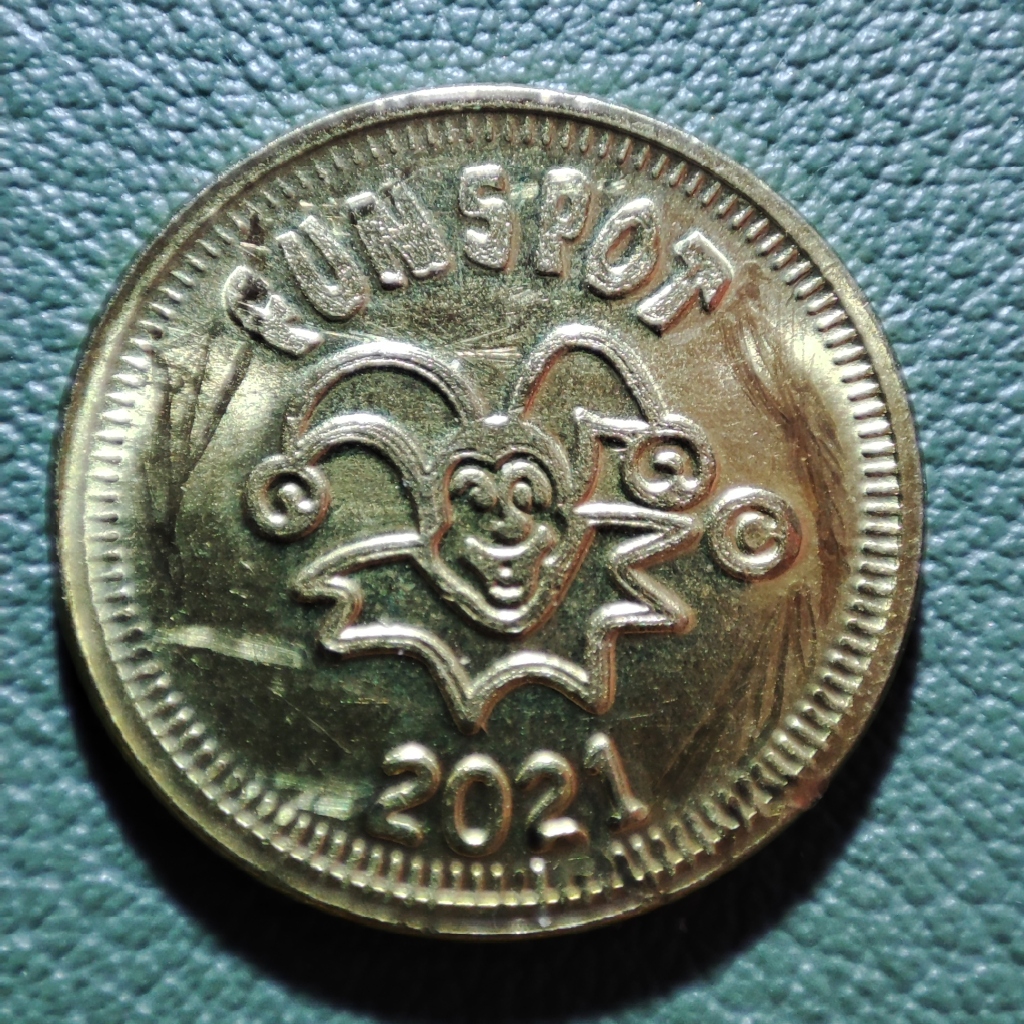
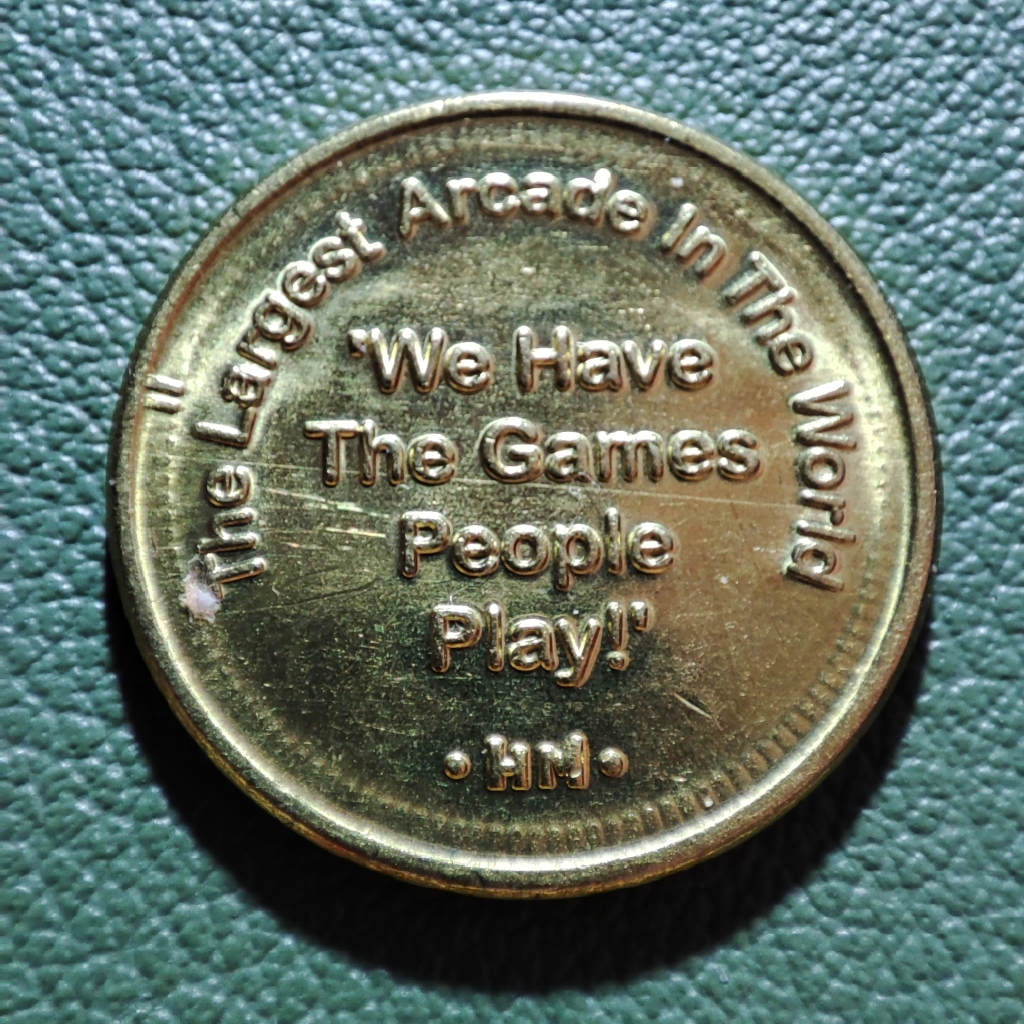
The more you buy, the cheaper they get. So if you’re going to be there for a stretch, it makes sense to buy the maximum 120 tokens for $20. That works out at not much more than 10p a token. While some of the big-ticket redemption games cost 3 or 4 tokens a play, the more familiar pinballs cost 2, and most of the arcade games 1. If you’re an even half-decent player, that makes for a fairly cheap evening’s entertainment. But that’s also a problem. Businesses like Funspot were hit pretty hard by the pandemic, the lockdowns, and the slow rebound in custom afterwards. I get that they don’t want to put their regular customers off by hiking their prices, but doing so might help them to give the place a bit of refurbishment. I don’t think it’s unfair to suggest that fixtures and fittings, and especially the carpets are starting to look a bit ‘tired’. Maybe fershening things up would also encourage even more people in?
When I first went, on a cold and dark Thursday evening in February, the whole place was deserted. And things weren’t that different on the Friday. Come Saturday during the day, however, the carparks were full, and the redemption-machine areas were rammed with families, with loads of small kids tearing about enjoying themselves. And I have to say, that made for a really nice atmosphere. While ACAM was moderately lively during the day, come 6 o’clock, it emptied out almost as if someone had flicked a switch! Having passed the time on my flight out to Boston with a private screening (!) of The King of Kong, I’d been expecting a throng of middle aged nerds to descend as the families left, and for there to be some serious jostling for position on the classic cabs, and pestering of the ‘part-timers’ with announcements of ‘Kill screens’. But that was not to be. Maybe it was just the time of year, but I suppose the rag-tag collection of 30 and 40-something gamers holding the fort in the movie, would be in their 50s by now or perhaps even older. Maybe they had other things to do? Or perhaps they’ve just drifted away from the arcade scene?


From a purely personal, and selfish point of view, however, that actually worked out rather well for me as a man on a time-limited mission. It meant I had the pick of the machines, and plenty of opportunities to take (bad) photos of them to boot.* But it did make me wonder about the viability of the place going forward. Given what Funspot/ACAM has come to symbolise in the arcade community, it would be a real shame if more of you didn’t get to see it.
On the whole, the bulk of the machines were very well looked-after, and there was clearly maintenance underway on others, even while I was there. Nevertheless, I don’t know if it was reflective of the winter doldrums, or a general trend, but far from all of the games were in good working order. A few were completely out of action, but that’s something you’d expect in any busy arcade. All the same, beyond that, I’d say that perhaps a quarter of the total had issues ranging from screen problems, to broken controls or non-functioning coin-slots, which meant you either couldn’t play them at all, or couldn’t play them in a way that was enjoyable. It would have been good to have a go on Forgotten Worlds, or Buck Rogers, or Pin Bot, or Super Bug, or Bandido for example, not to mention Sea Wolf. But they were all broke in one way or another.
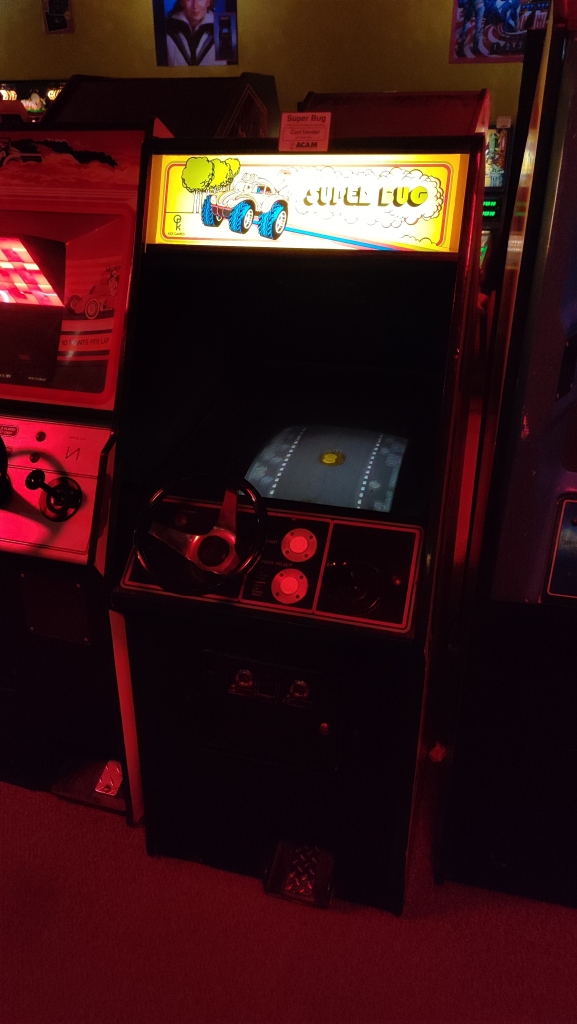

This, to me, points to problems. I’d suggest the easiest way to resolve them would be to replace the tokens with the kind of single entry fee used so successfully in the UK by Arcade Club, and others. Perhaps that would give ACAM the headroom it needs to help keep everything ship-shape, in Bristol fashion, and floating comfortably above the waterline? It would certainly save on the time and resources needed to fix dodgy coin mechanisms.
To conclude, you couldn’t argue that ACAM is the world’s biggest arcade. Depending on the specifics of the arcade experience you were after, it may not even have the ‘best’ collection of games in absolute terms. Based on what I’ve seen to date, that honour would have to go to the monumental, multi-level Arcade Club, Bury in England.
What ACAM does have to offer, however, is unique. It works well as a museum, but I think it’s real value is as a physical reinforcement of the idealised arcade of the early to mid-1980s. Although a mythical arcade in terms of its contents, ACAM has also achieved mythical status in its own right. But this is no fantasy arcade that you can only explore in your mind. You can actually go there, see it, and buy yourself a baseball cap to prove you’ve been!
What are you waiting for?!

* A note on the photos: I’m obviously no photographer. And I didn’t take a dedicated camera. Like most folks, I was stuck with the built-in camera on my less-than-flagship Android phone. While it seems to give reliably good results in daylight, the pre-sets struggle with multiple sources of bright light in an otherwise dark setting, eg. in a dimly lit video arcade! What this meant in practice was that I could only easily get a decent shot of the marquee, or the screen, or the cabinet, but never all three at the same time. The alternative, was to dial in the settings manually. While this worked for isolated locations, the non-uniform lighting in the arcade meant that settings that were perfect for one side of the room would have to be recalibrated for the other. This made it pretty difficult to capture consistently watchable video-footage. I realise the two obvious solutions are to invest in a better camera, and spend some time learning how to use it properly! But if anyone has any tips for apps or techniques to squeeze the most out of an Android camera in these kinds of condition, please leave them in the comments below.


Fantastic review. The photographs are fine and shame about the cabinets that were not available at the time of your visit. Maybe an entrance fee instead of buying tokens would help just as it is here in the UK mostly!
LikeLike
Thank you very much! ACAM was great, and I’m glad I went. I did so with managed expectations. With them running so many old arcade machines so hard, seven-days-a-week, there were bound to have been a few casualties. Maybe if they can’t change their funding model, they should think about reducing their hours, eg. opening at 3 pm or staying closed a couple of days of the week to let them troubleshoot and fix things a bit more systematically?
LikeLiked by 1 person